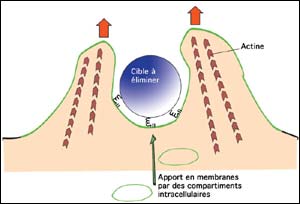Life Sciences and Chemistry
Articles and reports from the Life Sciences and chemistry area deal with applied and basic research into modern biology, chemistry and human medicine.
Valuable information can be found on a range of life sciences fields including bacteriology, biochemistry, bionics, bioinformatics, biophysics, biotechnology, genetics, geobotany, human biology, marine biology, microbiology, molecular biology, cellular biology, zoology, bioinorganic chemistry, microchemistry and environmental chemistry.

For ferrets, GPI means ’get pregnancy initiated’
Embryo-implant protein exploited by tumors may help endangered species
Knowing what makes a ferret pregnancy take hold could help biologists save endangered species or understand how tumors spread.
Specifically, biologists examining early pregnancy in domestic ferrets report they have identified a protein necessary for embryos to implant successfully in the wall of the uterus, which is pregnancy’s first step in mammals.
Newly discovered as a molecular signal i

Cellular cleansing: ARF6, a protein indispensable for the elimination of waste and pathogens
Like all living organisms, cells ingest foreign bodies, but not always as nutrients. Ingestion is also used to eliminate pathogens such as bacteria or harmful cellular waste. This cell function, known as phagocytosis, is vital, notably to the immune and inflammatory response.
CNRS research scientists at the Institut Curie have recently clarified the function of the protein ARF6 in phagocytosis, a mechanism which is still poorly understood. When ARF6 is lacking, the cells can eliminate neith

Researchers detect receptor for day/night cycles
It’s been something of a mystery to scientists – how are blind mice able to synchronize their biological rhythms to day and night? New research by a team of scientists, including one from the University of Toronto, seems to have uncovered the answer.
Rods and cones in the outer retina are the eyes’ main photoreceptors, explains Nicholas Mrosovsky, professor emeritus in zoology at U of T. When these rods and cones degenerate, mammals and animals become blind. Despite this, however, some ani

Harry Potter and the Ecuadorian flowers
A new species of the gentian family gets a Potteresque name
Harry Potter’s influence pervades even the science of plant taxonomy at Rutgers, The State University of New Jersey. Lena Struwe, assistant professor of ecology, evolution and natural resources at Rutgers’ Cook College – and a fan of the fictional young wizard – has shared in the discovery of a rare, new jungle plant that now bears a Potteresque name.
The new species, Macrocarpaea apparata , is descr

Rapid movements of living biomolecules visualised
Dutch researcher Chris Molenaar has made the rapid movements of proteins, DNA and RNA molecules visible in living cells. With this technique researchers can study the dynamics of biomolecules in their natural environment.
Molenaar developed a method which makes it possible to follow the movements of RNA molecules in living cells. The researcher also made the movements and interactions between proteins in living cells visible with the aid of the revolutionary “Green Fluorescent Protein”.

Study finds direction of enzymes affects DNA repair
DNA repair enzymes do a much better job of repairing damaged genes if they are facing in one direction instead of the other. This and other details of how DNA repair is performed are reported in the online version of the journal Proceedings of the National Academy of Sciences by researchers at Washington State University and the National Institute of Environmental Health Sciences.
According to the new study, the repair enzymes “distinguish” between various positions and may be two to three